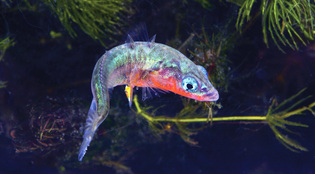 loading
loading
FindingsTruth in advertising Simon Booth/ Photo Researchers, Inc.View full imageTo attract a mate, the male three-spined stickleback, a small fish common in northern North America and Europe, turns bright red on its throat and performs an energetic zigzag dance. The displays are intended to show that he's in great shape and will be a fine parent; stickleback males guard their nests until the hatchlings can feed on their own. But many species in the animal kingdom give deceptive signals to attract mates. Can the stickleback be trusted? Ecology professor Suzanne Alonzo and Natasha Kelly ’11PhD have built a new mathematical model for species in which males rear the young. Existing theory ignored the fact that a stickleback father that looks good but abandons the nest will have fewer surviving offspring. For stickleback males, natural selection discourages deceptive displays. Alonzo and Kelly's model takes this into account, and it predicts, says Kelly, that sticklebacks and similar species “are sending honest signals.” Good parenting matters. (The work appears in the September 7 Proceedings of the Royal Society B: Biological Sciences.)
The comment period has expired.
|
|